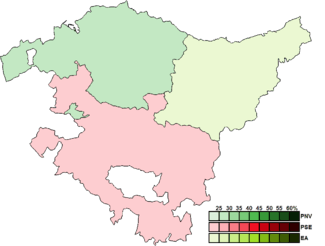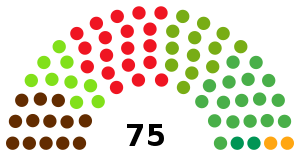Basque regional election, 1986
|
| |||||||||||||||||||||||||||||||||||||||||||||||||||||||||||||||||||||||||||||||||||||||||||||
| |||||||||||||||||||||||||||||||||||||||||||||||||||||||||||||||||||||||||||||||||||||||||||||
All 75 seats in the Basque Parliament 38 seats needed for a majority | |||||||||||||||||||||||||||||||||||||||||||||||||||||||||||||||||||||||||||||||||||||||||||||
|---|---|---|---|---|---|---|---|---|---|---|---|---|---|---|---|---|---|---|---|---|---|---|---|---|---|---|---|---|---|---|---|---|---|---|---|---|---|---|---|---|---|---|---|---|---|---|---|---|---|---|---|---|---|---|---|---|---|---|---|---|---|---|---|---|---|---|---|---|---|---|---|---|---|---|---|---|---|---|---|---|---|---|---|---|---|---|---|---|---|---|---|---|---|
| Opinion polls | |||||||||||||||||||||||||||||||||||||||||||||||||||||||||||||||||||||||||||||||||||||||||||||
| Registered |
1,660,143 | ||||||||||||||||||||||||||||||||||||||||||||||||||||||||||||||||||||||||||||||||||||||||||||
| Turnout |
1,155,815 (69.6%) | ||||||||||||||||||||||||||||||||||||||||||||||||||||||||||||||||||||||||||||||||||||||||||||
| |||||||||||||||||||||||||||||||||||||||||||||||||||||||||||||||||||||||||||||||||||||||||||||
 Constituency results map for the Basque Parliament | |||||||||||||||||||||||||||||||||||||||||||||||||||||||||||||||||||||||||||||||||||||||||||||
| |||||||||||||||||||||||||||||||||||||||||||||||||||||||||||||||||||||||||||||||||||||||||||||
The 1986 Basque regional election was held on Sunday, 30 November 1986, to elect the 3rd Parliament of the Basque Autonomous Community. All 75 seats in the Parliament were up for election.
The Socialist Party of the Basque Country (PSE–PSOE) won 19 seats, the Basque Nationalist Party (EAJ/PNV) came second with 17 seats, People's Unity (HB) and Basque Solidarity (EA), a PNV split, each won 13 seats, and Basque Country Left won 9 seats.
Overview
Electoral system
The Basque Parliament was the devolved, unicameral legislature of the autonomous community of the Basque Country, having legislative power in regional matters as defined by the Spanish Constitution and the Basque Statute of Autonomy, as well as the ability to vote confidence in or withdraw it from a Lehendakari.[1] Voting for the Parliament was on the basis of universal suffrage, which comprised all nationals over eighteen, registered in the Basque Country and in full enjoyment of their political rights.
The 75 members of the Basque Parliament were elected using the D'Hondt method and a closed list proportional representation, with a threshold of 5 percent of valid votes—which, unlike other electoral legislation in Spain, did not include blank ballots—being applied in each constituency. Parties not reaching the threshold were not taken into consideration for seat distribution. Seats were allocated to constituencies, corresponding to the Basque provinces of Álava, Biscay and Guipúzcoa. Each constituency was allocated a fixed number of 25 seats each, to provide for an equal representation of the three provinces in Parliament as required under the regional Statute of Autonomy.[1][2] This meant that Álava was allocated the same number of seats as Biscay and Gipuzkoa, despite their populations being, as of 1 July 1986: 268,532, 1,181,962 and 690,582, respectively.[3]
The electoral law provided that parties, federations, coalitions and groupings of electors were allowed to present lists of candidates. However, groupings of electors were required to secure at least the signature of 500 electors registered in the constituency for which they sought election. Electors were barred from signing for more than one list of candidates. Concurrently, parties and federations intending to enter in coalition to take part jointly at an election were required to inform the relevant Electoral Commission within ten days of the election being called.[2][4][5]
Election date
The term of the Basque Parliament expired four years after the date of its previous election, unless it was dissolved earlier. An election was required to take place within from thirty-six and forty-five days from the date of expiry of parliament. The previous election was held on 26 February 1984, which meant that the legislature's term would have expired on 26 February 1988. The election was required to be held no later than the forty-fifth day from dissolution, setting the latest possible election date for the Parliament on Monday, 11 April 1988.[1][2]
The Lehendakari had the prerogative to dissolve the Basque Parliament at any given time and call a snap election, provided that no motion of no confidence was in process. In the event of an investiture process failing to elect a Lehendakari within a sixty-day period from the Parliament re-assembly, the Parliament was to be dissolved and a fresh election called.[6]
Opinion polls
The table below lists voting intention estimates in reverse chronological order, showing the most recent first and using the dates when the survey fieldwork was done, as opposed to the date of publication. Where the fieldwork dates are unknown, the date of publication is given instead. The highest percentage figure in each polling survey is displayed with its background shaded in the leading party's colour. If a tie ensues, this is applied to the figures with the highest percentages. The "Lead" column on the right shows the percentage-point difference between the parties with the highest percentages in a given poll. When available, seat projections are also displayed below the voting estimates in a smaller font. 38 seats were required for an absolute majority in the Basque Parliament.
| Polling firm/Commissioner | Fieldwork date | Sample size | Turnout | Lead | |||||||
|---|---|---|---|---|---|---|---|---|---|---|---|
| 1986 regional election | 30 Nov 1986 | N/A | 69.6 | 23.6 17 |
22.0 19 |
17.4 13 |
4.8 2 |
10.8 9 |
3.5 2 |
15.8 13 |
1.6 |
| Emopública/Diario 16[p 1] | 23 Nov 1986 | ? | ? | ? 18/19 |
? 18/19 |
? 12/13 |
? 5 |
? 8 |
? 0 |
? 9/10 |
Tie |
| Bergareche/El Correo[p 1] | 23 Nov 1986 | ? | ? | ? 16/18 |
? 18/20 |
? 13/15 |
? 5/7 |
? 8/9 |
? 2 |
? 9/10 |
? |
| Demoscopia/El País[p 2][p 3][p 4] | 14–18 Nov 1986 | 1,500 | 65–68 | 25.0 20/21 |
24.0 19/20 |
? 9/10 |
? 2/3 |
? 7/8 |
? 1/3 |
? 13/14 |
1.0 |
| CINDE/Basque Government[p 5] | 14–18 Nov 1986 | 1,500 | ? | ? 20 |
? 18 |
? 12 |
? 3 |
? 10 |
? 2 |
? 10 |
? |
| CINDE/Basque Government[p 1] | 9–12 Nov 1986 | 1,200 | ? | 24.0 20 |
19.0 17 |
14.0 11 |
7.0 4 |
11.0 8 |
5.0 2 |
15.0 13 |
5.0 |
| Demoscopia/El País[p 6][p 7][p 8] | 7–11 Nov 1986 | 1,200 | 65–69 | 28.0 19/22 |
25.0 17/18 |
16.0 10/13 |
? 1/3 |
11.0 8/9 |
? 1/4 |
13.0 11/13 |
3.0 |
| PSOE[p 9] | 18 Oct 1986 | ? | ? | ? 14 |
? 18 |
? 13 |
? 6 |
? 8 |
? 2 |
? 14 |
? |
| Bergareche/El Correo[p 9] | 18 Oct 1986 | 2,545 | ? | ? 16 |
? 18/19 |
? 13/15 |
? 5 |
? 10/11 |
? 3 |
? 7/9 |
? |
| Iope–Etmar/Tiempo[p 9] | 7 Oct 1986 | ? | ? | 16.2 13 |
18.9 15 |
17.4 13 |
3.6 2 |
11.0 8 |
3.3 1 |
27.5 23 |
8.6 |
| Ikerfel/PNV[p 9] | 11–19 Sep 1986 | ? | ? | ? 20 |
? 17/18 |
? 11 |
? 7/8 |
? 8 |
? 1 |
? 10 |
? |
| Gaceta del Norte[p 9][p 10] | 12–17 Sep 1986 | ? | ? | ? 17 |
? 17 |
? 10 |
? 6 |
? 9 |
– | ?[lower-roman 1] 16 |
Tie |
| ? | ? 20 |
? 19 |
? 10 |
? 6 |
? 9 |
– | ? 11 |
? | |||
| 1986 general election | 22 Jun 1986 | N/A | 67.6 | 27.8 21 |
26.3 23 |
17.7 13 |
10.5[lower-roman 2] 9 |
9.1 7 |
5.0 2 |
– | 1.5 |
| 1984 regional election | 26 Feb 1984 | N/A | 68.5 | 41.8 32 |
23.0 19 |
14.6 11 |
9.3[lower-roman 2] 7 |
7.9 6 |
– | – | 18.8 |
| |||||||||||
Results
Overall
 | |||||||||
| Parties and coalitions | Popular vote | Seats | |||||||
|---|---|---|---|---|---|---|---|---|---|
| Votes | % | ±pp | Total | +/− | |||||
| Basque Nationalist Party (EAJ/PNV) | 271,208 | 23.60 | –18.21 | 17 | –15 | ||||
| Socialist Party of the Basque Country (PSE–PSOE) | 252,233 | 21.95 | –1.01 | 19 | ±0 | ||||
| Popular Unity (HB) | 199,900 | 17.40 | +2.81 | 13 | +2 | ||||
| Basque Solidarity (EA) | 181,175 | 15.77 | New | 13 | +13 | ||||
| Basque Country Left (EE) | 124,423 | 10.83 | +2.89 | 9 | +3 | ||||
| People's Alliance–Liberal Party (AP–PL)1 | 55,606 | 4.84 | –4.48 | 2 | –5 | ||||
| Democratic and Social Centre (CDS) | 40,445 | 3.52 | New | 2 | +2 | ||||
| United Left (IU/EB) | 6,750 | 0.59 | New | 0 | ±0 | ||||
| Communist Party of the Basque Country (PCE/EPK) | 5,675 | 0.49 | –0.90 | 0 | ±0 | ||||
| Workers' Socialist Party (PST) | 2,925 | 0.25 | +0.05 | 0 | ±0 | ||||
| Humanist Party (PH) | 1,400 | 0.12 | New | 0 | ±0 | ||||
| Internationalist Socialist Workers' Party (POSI) | 1,190 | 0.10 | New | 0 | ±0 | ||||
| Republican Popular Unity (UPR)2 | 1,102 | 0.10 | ±0.00 | 0 | ±0 | ||||
| Blank ballots3 | 5,003 | 0.44 | –0.03 | ||||||
| Total | 1,149,035 | 75 | ±0 | ||||||
| Valid votes | 1,149,035 | 99.41 | –0.01 | ||||||
| Invalid votes | 6,780 | 0.59 | +0.01 | ||||||
| Votes cast / turnout | 1,155,815 | 69.62 | +1.13 | ||||||
| Abstentions | 504,328 | 30.38 | –1.13 | ||||||
| Registered voters | 1,660,143 | ||||||||
| Sources[7][8] | |||||||||
| |||||||||
Distribution by constituency
| Constituency | PNV | PSE | HB | EA | EE | AP–PL | CDS | |||||||
|---|---|---|---|---|---|---|---|---|---|---|---|---|---|---|
| % | S | % | S | % | S | % | S | % | S | % | S | % | S | |
| Álava | 20.1 | 5 | 24.9 | 7 | 12.8 | 3 | 14.5 | 4 | 10.9 | 3 | 6.9 | 1 | 8.0 | 2 |
| Biscay | 28.8 | 8 | 22.5 | 6 | 16.0 | 4 | 11.7 | 3 | 10.2 | 3 | 5.1 | 1 | 3.2 | – |
| Guipúzcoa | 16.0 | 4 | 19.9 | 6 | 21.6 | 6 | 23.1 | 6 | 11.9 | 3 | 3.6 | – | 2.4 | – |
| Total | 23.6 | 17 | 22.0 | 19 | 17.4 | 13 | 15.8 | 13 | 10.8 | 9 | 4.8 | 2 | 3.5 | 2 |
| Sources[7][8] | ||||||||||||||
Aftermath
Investiture vote
| Choice | Vote | ||
|---|---|---|---|
| Parties | Votes | ||
| PSE (19), PNV (17), CDS (2) | 38 / 75 | ||
0 / 75 | |||
| Blank ballots | EA (13), EE (9), AP–PL (2) | 24 / 75 | |
| Absences: HB (13) | |||
| Source: historiaelectoral.com | |||
Notes
References
- Opinion poll sources
- 1 2 3 "Los sondeos pronostican diferencias mínimas entre el PNV y el PSOE". ABC (in Spanish). 27 November 1986.
- ↑ "Gaikoetxea y Benegas mejoran posiciones ante elecciones vascas". El País (in Spanish). 23 November 1986.
- ↑ "Garaikoetxea y los socialistas mejoran posiciones, aunque el PNV mantiene una exigua mayoría". El País (in Spanish). 23 November 1986.
- ↑ "Ficha técnica". El País (in Spanish). 23 November 1986.
- ↑ "El PNV obtendrá dos escaños más que el PSOE, según un sondeo del Gobierno vasco". ABC (in Spanish). 23 November 1986.
- ↑ "El PNV pierde respaldo, según un sondeo de EL PAÍS y la SER". El País (in Spanish). 15 November 1986.
- ↑ "Garaikoetxea robará más de 10 escaños al PNV". El País (in Spanish). 15 November 1986.
- ↑ "Ficha técnica del sondeo". El País (in Spanish). 15 November 1986.
- 1 2 3 4 5 "Las primeras encuestas revelan la confusión del electorado nacionalista vasco". ABC (in Spanish). 19 October 1986.
- ↑ "Igualdad de fuerzas". ABC (in Spanish). 22 September 1986.
- Other
- 1 2 3 "Statute of Autonomy for the Basque Country of 1979". Organic Law No. 3 of 18 December 1979. Official State Gazette (in Spanish). Retrieved 17 July 2017.
- 1 2 3 "Basque Parliament Elections Law of 1983". Law No. 28 of 25 November 1983. Official Gazette of the Basque Country (in Spanish). Retrieved 8 August 2017.
- ↑ "Principales series desde 1971. Resultados por Provincias. Población residente por fecha, sexo y edad". ine.es (in Spanish). National Institute of Statistics. Retrieved 8 August 2017.
- ↑ "General Electoral System Organic Law of 1985". Organic Law No. 5 of 19 June 1985. Official State Gazette (in Spanish). Retrieved 28 December 2016.
- ↑ "Representation of the people Institutional Act". juntaelectoralcentral.es. Central Electoral Commission. Retrieved 16 June 2017.
- ↑ "Government Law of 1981". Law No. 7 of 30 June 1981. Official Gazette of the Basque Country (in Spanish). Retrieved 17 July 2017.
- 1 2 "Election Results Archive". euskadi.eus (in Spanish). Basque Government. Retrieved 24 September 2017.
- 1 2 "Basque Parliament elections since 1980". historiaelectoral.com (in Spanish). Electoral History. Retrieved 24 September 2017.
.jpg)
.jpg)

.jpg)